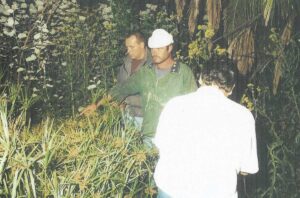Revisiting historical South African serial killer cases, it seems as if someone discovered the script of an old case and re-enacted it out 50 – 60 years later. Episode 6 of the television series Catch me a Killer, depicts the Cape Town Prostitute whom I profiled in 1996 and it is uncanny how many similarities there are between this case and the case of Cornelius Burger that occurred 60 years earlier in 1936 in Potchefstroom, South Africa.
During 1936 and 1937, the bodies of four sex workers were found dumped next to the Potchefstroom Road. Lieutenant Ulf Boberg of Marshall’s Plain Police Station in Johannesburg was appointed the chief investigating officer. After the fourth body was discovered, Boberg decided it was time for desperate measures. He assembled a team of detectives and devised a plan where the detectives would protect the sex workers while they worked. This required permission from the top brass, since prostitution was illegal and having police officers protecting them would be highly irregular. Given the gravity of the case, permission was granted and every sex worker was allocated one or two detectives who would watch her all night and record the registration numbers of the vehicles which picked her up. The sex workers were instructed to inform their clients to drop them off at the same spot before they even got into their vehicles. Only when all the sex workers were accounted for the night and all of them were safely home, were the detectives allowed to clock off duty. For months this routine was followed, much to the annoyance of the detectives.
The same procedure of detectives keeping the sex workers under surveillance and taking note of the vehicles picking them up, were followed in our investigation in 1996 in Cape Town, led by Sergeant Piet Viljoen. Many a prominent businessman and even a few police officers’ vehicle registration numbers featured on our list, but we kept these confidential. There was no need to unnecessary ruffle feathers and distract the investigating team from the main aim – to catch the killer. The sex workers’ photographs and fingerprints taken, as a precaution – since sex workers are difficult to identify, due to the aliases they use. Sex workers are not often reported missing under their real names. This was all voluntary, but most complied.
Returning to the 1937-investigation, one night, just after midnight, Boberg was waiting for his detectives to check in. All but one were present. As he was about to send out a search party, the detective arrived to announce that “his” sex worker, Mavis Davids had not returned. The detective issued Boberg the vehicle registration number and the address of the owner of the vehicle was traced.
In the 1996 Cape Town Prostitute killer case, our suspect was also traced through his vehicle being noted by the sex workers. It was a blue pick-up truck.
Boberg decided it was more important to find Mavis first before they confronted the suspect. Detectives were dispatched to search the Potchefstroom and Heidelberg roads. Mavis was found on the Potchefstroom Road, she had been assaulted, was bleeding, but miraculously still alive. She recounted that a man in a large black vehicle had picked her up. She became anxious when he drove out on the Potchefstroom Road. When he stopped the vehicle, Mavis tried to escape, but he grabbed her and strangled her. That was all that she could remember when she lost consciousness until the detectives found her. She was not sexually assaulted.
The detectives set out for the address of the suspect. They arrived at his home before he did and waylaid him. When Cornelius Burger, a man in his mid-thirties, arrived later that night, he was surprised by detectives who held him at gunpoint. He did not resist arrest and accompanied them to his room where they found the handbags of the murdered sex workers in his cupboard. Mavis’ handbag was still in his vehicle. Three of the handbags were positively linked to three murdered sex workers. Many serial killers keep souvenirs of their victims, which they use to stimulate themselves when fantasizing about the murders.
Cornelius was married, but separated from his wife. They did not share a bedroom and hardly spoke to one another. Cornelius had established that he had contracted a venereal disease and that it was too late to cure the disease. He had sworn revenge on the sex workers and strangled them one by one. Ex FBI profiler Roy Hazelwood taught me in a case where sex workers are victims, it is important to establish whether the killer just chose them because of their vulnerability and easy access or specifically due to their vocation. Clearly this was a case of the latter, as was the case in our 1996 investigation. In the 1996 case of the Cape Town Prostitute killer, our suspect was divorced and lived in a caravan close to his ex-wife’s home. He had also contracted a venereal disease and was impotent.
In the 1937 case, a doctor had found that Cornelius’ venereal disease had already infested his mind and he was found not fit to stand trial due to mental illness. Although circumventing a trial, he did not escape incarceration and was institutionalized for life. Cornelius’ mental illness progressed rapidly and he died quite mad in an institution.
The Cape Town Prostitute suspect feigned amnesia and madness and a psychiatrist confirmed he was malingering or faking. He was held in custody, awaiting trial for about a year, but finally released due to lack of evidence. The murders continued after his release.
A few years after the Cornelius Burger case, in 1940 another serial killer prowled the streets of Wynberg, Cape Town.
On 14 September 1940, Mrs Evelyn Chalmers was busy baking in her kitchen in Wynberg in Cape Town, when she was suddenly overpowered by a youth. She managed to scream whereupon her assailant fled and sped away on his bicycle. Mrs Chalmers would never forget the face of her assailant.
Nineteen days later on 3 October 1940, Mrs Ethel Marais of Landsdown, was on her way home after seeing her husband off at the station. Before she reached her house, Mrs Marais was brutally attacked. Her head and face were bludgeoned with a blunt object, her hands were tied up with her stockings and a scarf was wrapped around her mouth. Her underwear was missing. Mrs Marais was rushed to hospital but she never regained consciousness and died due to more than 20 wounds on her battered body. Mrs Marais’ ring and the clasp of her turban were missing.
Exactly nineteen days on 23 October, Mrs Dorothy Marie Tarling was found hacked to death in her dining room in Wynberg. She was half naked and pillows were scattered on her head and buttocks. Her skull was bashed in and there were 20 wounds on her body. The assailant had ransacked the house and a foreign fingerprint was discovered in one of the drawers.
Nineteen days after this attack, on 11 November 1940 at ten o’clock in the morning, Miss Evangeline Bird, a lodger in Wynberg, went outside to give an order to a delivery man called Achmat Rawoot. Five minutes later, Mrs Spolander, her landlady spotted blood on the stairs outside and a shoe. She found Miss Bird’s battered body under a bush. Her dress was pulled up and her underwear pulled down to her knees. She died due to head injuries and she was not raped. Rawoot had noticed a man with a bicycle with a red tyre in the vicinity. When he returned a little later to the Spolander’s home with his deliveries he noticed the same young man again chopping wood.
At this stage Major PH Golby, the chief of police took charge of the case.
Nineteen days later on 30 November 1940, at 7 pm Mr Jones, lodging at Mrs Mary Overton Hoets of Rondebosch returned home to find the top part of the back door open. He discovered Mrs Hoets’ body lying spread eagled on her bed. There was a gash in her neck and her head was smashed in. Mrs Hoets’ body was covered with about 20 wounds. The police found fingerprints in Mrs Hoets’ and Mr Jones room as well as a foot print outside Mrs Hoets’ bedroom and a bicycle tyre track.
The head of the detective unit in Pretoria, Colonel J Coetzee was summoned down to Cape Town to take over the case. The description of the suspect was a man of five feet ten inches in height with a copper-coloured face, who rode a bicycle with a red tyre. The police contacted owners of bicycle shops to try and trace the bicycle. There was no official record of matching fingerprints. The police informed the media that they had the left thumb print of the suspect.
Nineteen days passed while the police waited in anticipation for the next murder, but there was no murder forthcoming. Instead three complaints regarding a youth committing indecent assault were made. The first was when a young man exposed himself to a woman in Ainsley Road, Plumstead, but he cycled away.
The second was a woman who was accosted in Bayview Road, Wynberg when a young man tried to lift up her dress and remove her underwear. She struggled with the assailant and managed to break free.
The third incident happened in Timour Hill Road, Wynberg when a young man cycled passed a woman and grabbed her around her neck. He followed her home and then left. The next day she saw him hanging around on his bicycle opposite her house. She threatened him with the police but when they arrived, he had fled. Three days later she spotted him again and asked a delivery man to follow him to see where he lived.
The delivery man told the police that he knew the young man by sight and that the suspect frequented the Gaiety Cinema in Wynberg. The police held a stake out at the cinema and it was here that Sergeant Ernest Engelke arrested the suspect on the charge of indecent assault. He did not charge him with the murders, yet.
At the Wynberg Police Station the man identified himself as 20-year-old Salie Lingevelt who lived with his father in Douglas Road. Salie was wearing the ring he had stolen from Mrs Marais. A house search turned up Mrs Marais’ turban clasp and the red bicycle tyre hidden under Salie’s bed. Most extraordinary, Salie had chopped off the tip of his left thumb to prevent the police from identifying him with this fingerprint but the police had intentionally leaked misinformation to the press and their ingenuity paid off for his right thumb matched the print they had found in Mrs Hoets’ house.
Salie was pointed out at the identity parade by Mrs Chalmers who luckily escaped being his first victim. Salie refused council and said he preferred life in prison to the one he had. His mother had died a few years prior and he felt sorry for his father who was good to him. He said that he committed the murders because his “boss’ gave him the orders to do so. He did not want to divulge who the “boss” was.
In 1994, Norman Simons, the Station Strangler, attributed the killings to the voice of his brother Boyzie, “who lived inside him and ordered him to kill”. He also claimed he was bewitched as a child. Dr Tobiah Zabow, psychiatrist at Valkenburg Hospital found him sane and mentally fit to stand trial.
Joseph Kallinger of Philadelphia, USA, killed three people, including his son from 1974 to 1975. Joseph was mentally insane and believed himself to be chosen by God to annihilate mankind. Joseph blamed his alter ego called “Charlie” for the murders.
Ted Bundy, who killed 19 young female college students all over America from 1974 to 1978, called this urge “the force”. Ted confessed in the third person singular, thereby avoiding accountibility for his acts. This was the same time when John Kgabi was killing little girls in Atteridgeville.
Kenny Bianchi and his older cousin Angelo Buono, known as the Hillside Strangers killed ten women in Los Angeles, between 1977 and 1979. Kenny killed another two women on his own in January 1979 in Washington. Kenny claimed to have suffered from Dissociated Identity Disorder and attributed the murders to an alter personality called “Steve”.
Salie was assessed by psychiatrists who could not find evidence of mental illness and declared him fit to stand trial. Salie had made a full confession and even pointed out where he had hidden the murder weapon. It was an iron bar. Judge Davis, made a typical error of assuming no sane person could commit such brutal murders and he could not accept that Salie was not mentally ill. The judge presumed Salie must have acted according to some sexual perversity. Salie refused to acknowledge that there was any sexual element in his crimes, yet during the trial it was pointed out that he had no need to tie up Mrs Marais’ hands with her stockings, as she was already unconscious from the head blows. Had he wanted to tie her up to drag her, he could have used her scarf.
This kind of bondage correlates with the bondage done by Sipho Twala, the Sugar Cane Killer I profiled in 1997, who also tied up his victims although they were already unconscious due to an assault to the head or face. Like Salie, Sipho Twala had a fetish for women’s underwear, and he formed a little ball which he placed in the unconscious women’s mouths – totally unnecessary since they could not scream. He told me he placed the ball into his own mouth first to see if it would fit. Such unnecessary bondage is a sign of a serial killer acting out a fantasy.
During his trial Salie Lingevelt expressed the wish to be hanged. Mr Justice R. P. B. Davis complied, found him guilty of the murders and sentenced him to death. When the date of his execution finally dawned in Pretoria, Salie cheerfully walked up to the scaffold.
These case studies demonstrate how serial killers try to make sense of their compulsions to kill, by attributing it to an external force – giving it an alias name – yet it the urge to kill is lodged firmly within their psyche. These are not hallucinations or Dissociated Identity Disorder. In psychology, it is called confabulation, when the mind fills in gaps to try and make sense of something it does not understand.
Are psychologists, psychiatrists or members of the legal profession sometimes fooled into believing that some serial killers are mentally ill, when they are not, just because it is so difficult for them to believe a sane person can commit a heinous act? The serial killers in this case study may present a similar modus operandi, but each had his own idiosyncratic sexual fantasy acted out on the crime scene, often involving a fetish. Often impotent men will find substitute gratification through fetishes, for impotence does not eliminate the desire for sexual relations in these killers – it simply finds another horrendous avenue of expressing itself.
Cover photo: The rustic peaceful ambience of Wynberg in Cape Town was brutalized in the 1940’s by Salie Lingevelt, a serial killer who randomly bludgeoned women to death in their homes (Public Domain)






